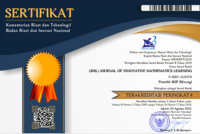Increasing Students' Self-Efficacy Through A Realistic Mathematical Education
DOI:
https://doi.org/10.22460/jiml.v4i2.p63-74Keywords:
Realistic mathematics education Students' self-efficacyAbstract
References
Arslan, N. (2017). Investigating the Relationship between Educational Stress and Emotional Self-Efficacy. Universal Journal of Educational Research.
https://eric.ed.gov/?id=EJ1155536
Bandura, A. (1978). Reflections on self-efficacy. Advances in Behaviour Research and Therapy, 1(4), 237–269. https://doi.org/10.1016/0146-6402(78)90012-7
Bandura, A. (1994). Encyclopedia of mental health. 4, 71–81.
http://www.des.emory.edu/mfp/BanEncy.html
Bandura, A. (2010). Perceived Self-Efficacy in Cognitive Development and Functioning. Educational Psychologist, 28(2), 117–148.
https://doi.org/10.1207/S15326985EP2802_3
Bandura, A. (2013). Regulative Function Of Perceived Self-Efficacy. Psychology Press. https://doi.org/10.4324/9780203773918-22
Brophy, J. (1986). Teaching and Learning Mathematics: Where Research Should Be Going. Journal for Research in Mathematics Education, 17(5), 323–346.
https://doi.org/10.5951/JRESEMATHEDUC.17.5.0323
Caine, R. N. G. (1991). Making Connections: Teaching and the Human Brain. Association for Supervision and Curriculum Development, 11141 Georgia Avenue, Suite 200, Wheaton, MD 20902 (ASCD Stock No. 611-91025, $15.95).
Candela, L., Dalley, K., & Benzel-Lindley, J. (2006). A Case for Learning-Centered Curricula. Journal of Nursing Education; Thorofare, 45(2), 59–66. https://www.proquest.com/openview/878935391f45035e7d7815656532fd5e/1?pq-origsite=gscholar&cbl=47628
Carpenter, T. P., Fennema, E., Peterson, P. L., Chiang, C.-P., & Loef, M. (2016). Using Knowledge of Children’s Mathematics Thinking in Classroom Teaching: An Experimental Study. Journals.Sagepub.Com, 26(4), 499–531.
https://doi.org/10.3102/00028312026004499
Chang, M. C., Al- Samarrai, S., Shaeffer, S., Ragatz, A. B., Ree, J. de, & Stevenson, R. (2014). Teacher Reform in Indonesia: The Role of Politics and Evidence in Policy Making - Mae Chu Chang, Samer Al-Samarrai, Sheldon Shaeffer, Andrew B. Ragatz, Joppe de Ree, Ritchie Stevenson - Google Buku. The Word Bank, Washington. https://books.google.co.id/books?hl=id&lr=&id=NfxMAgAAQBAJ&oi=fnd&pg=PP2&dq=In+improving+the+quality+of+education+in+Indonesia,+the+government+has+made+various+efforts+including+completing+various+educational+facilities+and+infrastructure,+improving+the+q
De Clercq, D., Haq, I. U., & Azeem, M. U. (2018). Workplace ostracism and job performance: roles of self-efficacy and job level. Personnel Review, 48(1), 184–203. https://doi.org/10.1108/PR-02-2017-0039
Durowoju, E., Onuka, A. O. U., & Oni, A. A. (2020). Assessment Strategies for Improving the Teaching-Learning Process for Quality Outcomes. FIRE: Futuristic Implementations of Research in Education, 1(2), 108–121.
http://firejournal.org/index.php/fire/article/view/21
Ensor, P. (2001). From Preservice Mathematics Teacher Education to Beginning Teaching: A Study in Recontextualizing. Journal for Research in Mathematics Education, 32(3), 296–320. https://doi.org/10.2307/749829
Etherton, K., Steele-Johnson, D., Salvano, K., & Kovacs, N. (2020). Resilience effects on student performance and well-being: the role of self-efficacy, self-set goals, and anxiety. The Journal of General Psychology. https://doi.org/10.1080/00221309.2020.1835800
Gainsburg, J. (2008). Real-world connections in secondary mathematics teaching. Journal of Mathematics Teacher Education, 11(3), 199–219. https://doi.org/10.1007/S10857-007-9070-8
Gee, E., Fauzan, A., & Atmazaki, A. (2018). Designing learning trajectory for teaching sequence and series using RME approach to improve students’ problem solving abilities. Journal of Physics: Conference Series, 1088(1), 012096.
https://doi.org/10.1088/1742-6596/1088/1/012096
Gorson, J., & O’rourke, E. (2019). How Do Students Talk About Intelligence? An Investigation of Motivation, Self-efficacy, and Mindsets in Computer Science. Proceedings of the 2019 ACM Conference on International Computing Education Research, 19. https://doi.org/10.1145/3291279
Graham, S., & Harris, K. R. (1989). Components Analysis of Cognitive Strategy Instruction: Effects on Learning Disabled Students’ Compositions and Self-Efficacy. Journal of Educational Psychology, 81(3), 353–361. https://doi.org/10.1037/0022-0663.81.3.353
Harlen, W., & Qualter, A. (2018). The Teaching of Science in Primary Schools. The Teaching of Science in Primary Schools. https://doi.org/10.4324/9781315398907
Kaiser, G. (2020). Mathematical Modelling and Applications in Education. Encyclopedia of Mathematics Education, 553–561. https://doi.org/10.1007/978-3-030-15789-0_101
Kol, M. (2014). An Investigation of pre-service mathematics teachers’ mathematizing during a mathematical modeling task. Metu.Edu.Tr.
https://open.metu.edu.tr/handle/11511/24166
Linder, S. M., Powers-Costello, B., & Stegelin, D. A. (2011). Mathematics in Early Childhood: Research-Based Rationale and Practical Strategies. Early Childhood Education Journal, 39(1), 29–37. https://doi.org/10.1007/S10643-010-0437-6
Lippke, S. (2020). Self-Efficacy Theory. Encyclopedia of Personality and Individual Differences, 4722–4727. https://doi.org/10.1007/978-3-319-24612-3_1167
Meyer, D. K., Turner, J. C., & Spencer, C. A. (2015). Challenge in a Mathematics Classroom: Students’ Motivation and Strategies in Project-Based Learning. Journals.Uchicago.Edu, 97(5). https://doi.org/10.1086/461878
Morris, S. B. (2007). Estimating Effect Sizes From Pretest-Posttest-Control Group Designs. Organizational Research Methods, Journals.Sagepub.Com, 11(2), 364–386. https://doi.org/10.1177/1094428106291059
Öqvist, A., & Malmström, M. (2017). What motivates students? A study on the effects of teacher leadership and students’ self-efficacy. International Journal of Leadership in Education, 21(2), 155–175. https://doi.org/10.1080/13603124.2017.1355480
Pajares, F. (2006). SelfEfficacy Beliefs of Adolescents - Google Buku. IAP.
https://books.google.co.id/books
Pajares, F. (2008). Motivation and Self-Regulated Learning: Theory, Research, and Applications - Google Buku. Routledge.
Papadakis, S., Kalogiannakis, M., & Zaranis, N. (2017). Designing and creating an educational app rubric for preschool teachers. Education and Information Technologies, 22(6), 3147–3165. https://doi.org/10.1007/S10639-017-9579-0
Ramlan, A. M. (2016). The Effect Of Van Hiele Learning Model Toward Geometric Reasoning Ability Based On Self-Efficacy Of Senior High School Students. Journal of Mathematics Education. http://usnsj.com/index.php/JME
Rowland, T. (2003). Mathematics as Human Activity: A Different Handshakes Problem. The Mathematics Educator, 7(2), 55–70.
https://nrich.maths.org/content/id/11016/Mathematics as Human Activity.pdf
Scardamalia, M., & Bereiter, C. (2009). Higher Levels of Agency for Children in Knowledge Building: A Challenge for the Design of New Knowledge Media. The Journal of the Learning Sciences, 1(1), 37–68. https://doi.org/10.1207/S15327809JLS0101_3
Sembiring, R. K., Hadi, S., & Dolk, M. (2008). Reforming mathematics learning in Indonesian classrooms through RME. Springer ZDM, 40(6), 927–939.
https://doi.org/10.1007/S11858-008-0125-9
Seo, M. gu, & Ilies, R. (2009). The role of self-efficacy, goal, and affect in dynamic motivational self-regulation. Organizational Behavior and Human Decision Processes, 109(2), 120–133. https://doi.org/10.1016/J.OBHDP.2009.03.001
Siregar, R. N., Karnasih, I., & Hasratuddin, H. (2020). Pengembangan Perangkat Pembelajaran Berbasis Pendekatan Realistik Untuk Meningkatkan Kemampuan Berfikir Kreatif Dan Self-Efficacy Siswa SMP. JURNAL PENDIDIKAN GLASSER, 4(1), 45–63. https://doi.org/10.32529/GLASSER.V4I1.441
Siregar, R. N., Mujib, A., Siregar, H., & Karnasih, I. (2020). Peningkatan Kemampuan Berpikir Kreatif Siswa Melalui Pendekatan Matematika Realistik. Edumaspul: Jurnal Pendidikan, 4(1), 56–62. https://doi.org/10.33487/EDUMASPUL.V4I1.338
Siregar, R. N., & Prabawanto, S. (2020). Self-Efficacy Siswa Dalam Menghadapi Tugas-Tugas Matematis Non Rutin Ditinjau Dari Kemampuan Awal Matematika Siswa. INTEGRASI TEKNOLOGI DALAM PEMBELAJARAN MATEMATIKA KREATIF DI ERA KENORMALAN BARU. http://econference.stkip-pgri-sumbar.ac.id/index.php /matematika/itpmkeb/paper/view/1215
Sumirattana, S., Makanong, A., & Thipkong, S. (2017). Using realistic mathematics education and the DAPIC problem-solving process to enhance secondary school students’ mathematical literacy. Kasetsart Journal of Social Sciences, 38(3), 307–315. https://doi.org/10.1016/J.KJSS.2016.06.001
Van Den Heuvel-Panhuizen, M. (2003). The didactical use of models in realistic mathematics education: An example from a longitudinal trajectory on percentage. Educational Studies in Mathematics, 54(1), 9–35.
https://doi.org/10.1023/B:EDUC.0000005212.03219.DC
Wood, R., & Bandura, A. (1989). Social Cognitive Theory of Organizational Management. Academy of Management Review - Journals.Aom.Org, 14(3), 361–384.
https://doi.org/10.5465/AMR.1989.4279067
Wubbels, T., Korthagen, F., & Broekman, H. (1997). Preparing teachers for realistic mathematics education. Educational Studies in Mathematics 1997 32:1, 32(1), 1–28. https://doi.org/10.1023/A:1002900522457
Zeichner, K. (1994). Research on Teacher Thinking and Different Views of Reflective Practice in Teaching and Teacher Education. Academia.Edu.
https://d1wqtxts1xzle7.cloudfront.net/45890570/1994
Zientek, L., Nimon, K., & Hammack-Brown, B. (2016). Analyzing data from a pretest-posttest control group design: The importance of statistical assumptions. European Journal of Training and Development, 40(8–9), 638–659.

























